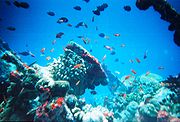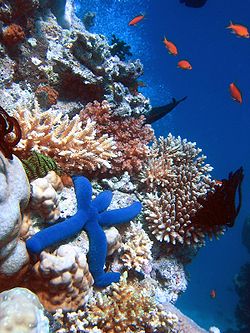
Marine ecosystem
Encyclopedia


Aquatic ecosystem
An aquatic ecosystem is an ecosystem in a body of water. Communities of organisms that are dependent on each other and on their environment live in aquatic ecosystems. The two main types of aquatic ecosystems are marine ecosystems and freshwater ecosystems....
s. They include ocean
Ocean
An ocean is a major body of saline water, and a principal component of the hydrosphere. Approximately 71% of the Earth's surface is covered by ocean, a continuous body of water that is customarily divided into several principal oceans and smaller seas.More than half of this area is over 3,000...
s, salt marsh
Salt marsh
A salt marsh is an environment in the upper coastal intertidal zone between land and salt water or brackish water, it is dominated by dense stands of halophytic plants such as herbs, grasses, or low shrubs. These plants are terrestrial in origin and are essential to the stability of the salt marsh...
and intertidal ecology
Intertidal ecology
Intertidal ecology is the study of intertidal ecosystems, where organisms live between the low and high tide lines. At low tide, the intertidal is exposed whereas at high tide, the intertidal is underwater...
, estuaries
Estuary
An estuary is a partly enclosed coastal body of water with one or more rivers or streams flowing into it, and with a free connection to the open sea....
and lagoon
Lagoon
A lagoon is a body of shallow sea water or brackish water separated from the sea by some form of barrier. The EU's habitat directive defines lagoons as "expanses of shallow coastal salt water, of varying salinity or water volume, wholly or partially separated from the sea by sand banks or shingle,...
s, mangrove
Mangrove
Mangroves are various kinds of trees up to medium height and shrubs that grow in saline coastal sediment habitats in the tropics and subtropics – mainly between latitudes N and S...
s and coral reef
Coral reef
Coral reefs are underwater structures made from calcium carbonate secreted by corals. Coral reefs are colonies of tiny living animals found in marine waters that contain few nutrients. Most coral reefs are built from stony corals, which in turn consist of polyps that cluster in groups. The polyps...
s, the deep sea
Deep sea
The deep sea, or deep layer, is the lowest layer in the ocean, existing below the thermocline and above the seabed, at a depth of 1000 fathoms or more. Little or no light penetrates this part of the ocean and most of the organisms that live there rely for subsistence on falling organic matter...
and the sea floor
Benthos
Benthos is the community of organisms which live on, in, or near the seabed, also known as the benthic zone. This community lives in or near marine sedimentary environments, from tidal pools along the foreshore, out to the continental shelf, and then down to the abyssal depths.Many organisms...
. They can be contrasted with freshwater ecosystems, which have a lower salt
Salt
In chemistry, salts are ionic compounds that result from the neutralization reaction of an acid and a base. They are composed of cations and anions so that the product is electrically neutral...
content. Marine waters cover two-thirds of the surface of the Earth. Such places are considered ecosystems because the plant life supports the animal life and vice-versa. See food chain
Food chain
A food web depicts feeding connections in an ecological community. Ecologists can broadly lump all life forms into one of two categories called trophic levels: 1) the autotrophs, and 2) the heterotrophs...
s.
Marine ecosystems are very important for the overall health of both marine and terrestrial environments. According to the World Resource Center, coastal habitats alone account for approximately 1/3 of all marine biological productivity, and estuarine ecosystems (i.e., salt marshes, seagrasses, mangrove forests) are among the most productive regions on the planet. In addition, other marine ecosystems such as coral reef
Coral reef
Coral reefs are underwater structures made from calcium carbonate secreted by corals. Coral reefs are colonies of tiny living animals found in marine waters that contain few nutrients. Most coral reefs are built from stony corals, which in turn consist of polyps that cluster in groups. The polyps...
s, provide food and shelter to the highest levels of marine diversity in the world.
Marine ecosystems usually have a large biodiversity and are therefore thought to have a good resistance against invasive species
Invasive species
"Invasive species", or invasive exotics, is a nomenclature term and categorization phrase used for flora and fauna, and for specific restoration-preservation processes in native habitats, with several definitions....
. However, studies do not always correlate with this theory leading researchers to argue about the mechanisms responsible in determining the success of an invasion.
See also
- Aquatic ecosystemAquatic ecosystemAn aquatic ecosystem is an ecosystem in a body of water. Communities of organisms that are dependent on each other and on their environment live in aquatic ecosystems. The two main types of aquatic ecosystems are marine ecosystems and freshwater ecosystems....
- Aquatic toxicologyAquatic toxicologyAquatic toxicology is the study of the effects of manufactured chemicals and other anthropogenic and natural materials and activities on aquatic organisms at various levels of organization, from subcellular through individual organisms to communities and ecosystems.In the United States aquatic...
- HydrobiologyHydrobiologyHydrobiology is the science of life and life processes in water. Much of modern hydrobiology can be viewed as a sub-discipline of ecology but the sphere of hydrobiology includes taxonomy, economic biology, industrial biology, morphology, physiology etc. The one distinguishing aspect is that all...
- IMBERIMBERIMBER is an - sponsored international project focussing on ocean biogeochemical cycles and ecosystems.The goal of IMBER is to investigate the sensitivity of marine biogeochemical cycles and ecosystems to global change, on time scales ranging from years to decades...
- Large marine ecosystemLarge marine ecosystemLarge marine ecosystems are regions of the world's oceans, encompassing coastal areas from river basins and estuaries to the seaward boundaries of continental shelves and the outer margins of the major ocean current systems...
- Marine biologyMarine biologyMarine biology is the scientific study of organisms in the ocean or other marine or brackish bodies of water. Given that in biology many phyla, families and genera have some species that live in the sea and others that live on land, marine biology classifies species based on the environment rather...
- Marine habitatsMarine habitatsThis article is about the habitats that support marine life. Marine life depends in some way on the saltwater that is in the sea . A habitat is an ecological or environmental area inhabited by one or more living species.Marine habitats can be divided into coastal and open ocean habitats...
- Tropical marine climate
External notes
- Barange M, Field JG, Harris RP, Eileen E, Hofmann EE, Perry RI and Werner F (2010) Marine Ecosystems and Global Change Oxford University Press. ISBN 9780199558025
- Boyd IL, Wanless S and Camphuysen CJ (2006) Top predators in marine ecosystems: their role in monitoring and management Volume 12 of Conservation biology series. Cambridge University Press. ISBN 9780521847735
- Davenport J (2008) Challenges to Marine Ecosystems: Proceedings of the 41st European Marine Biology Symposium Volume 202 of Developments in hydrobiology. ISBN 9781402088070
- Levner E, Linkov I and Proth J (2005) Strategic management of marine ecosystems Springer. Volume 50 of NATO Science Series IV. ISBN 9781402031588
- Mann KH and Lazier JRN (2006) Dynamics of marine ecosystems: biological-physical interactions in the oceans Wiley-Blackwell. ISBN 9781405111188
- Moustakas A and Karakassis I (2005) "How diverse is aquatic biodiversity research?" Aquatic Ecology, 39: 367-375.]
External links
- Marine Ecosystems US Environmental Protection Agency.
- Marine ecosystem (2008). In Encyclopædia Britannica. Retrieved October 11, 2008, from Encyclopædia Britannica Online.
- Smithsonian Ocean Portal

